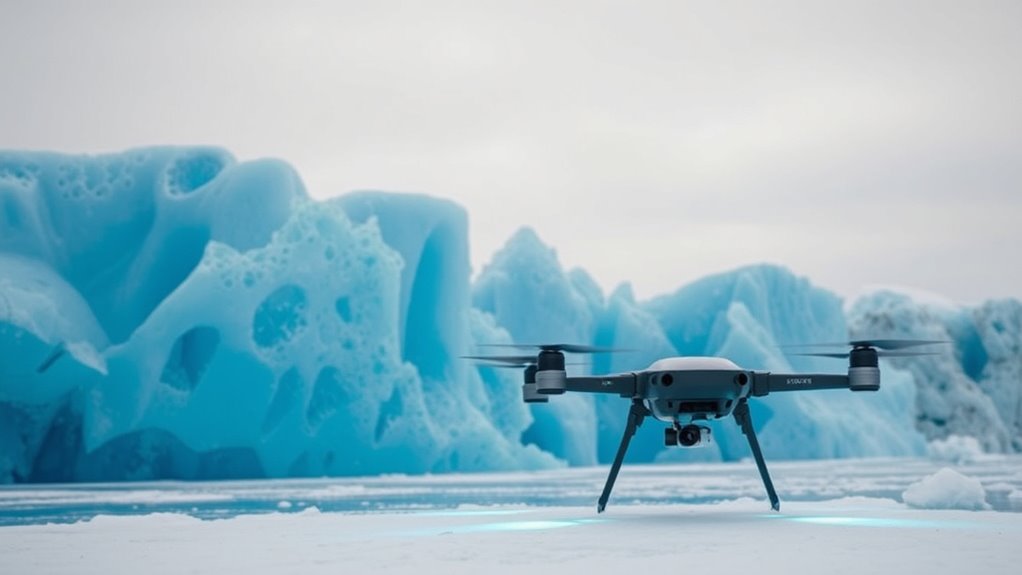AI is revolutionizing how scientists explore mysteries beneath the Antarctic ice shelf. It quickly analyzes seafloor images, revealing unique and vulnerable species, while also mapping ice sheet behavior and identifying hidden thaw zones that can destabilize glaciers. AI-driven models uncover key climate drivers like wind patterns that cause melting. Additionally, autonomous systems and remote sensing tools provide real-time data on ice movement and biodiversity, helping researchers understand complex processes. Keep exploring to discover how AI continues to unseal Antarctica’s secrets.
Key Takeaways
- AI-powered radar mapping reveals basal ice temperatures and hidden thaw zones beneath Antarctic ice sheets.
- Machine learning analyzes satellite and aerial data to understand ice flow dynamics and stability.
- AI-enhanced remote sensing tracks ice movement and environmental changes in real-time.
- Digital platforms facilitate data sharing, enabling global collaboration on ice shelf research.
- AI accelerates analysis of seafloor animal images, identifying biodiversity hotspots impacting ice stability.

Advancements in artificial intelligence are revolutionizing how scientists explore and understand the Antarctic ice shelf. With AI, tasks that used to take hours now only take seconds, dramatically speeding up research. For example, the British Antarctic Survey (BAS) combines AI with expert review to analyze seafloor animal images rapidly. This technology allows you to see and label seafloor images in near real-time while aboard research vessels, enabling expansive coverage of the seafloor. Because over 94% of species in the Southern Ocean are unique and vulnerable to climate change, your ability to quickly identify biodiversity hotspots becomes essential for conservation efforts. AI accelerates detection of animals in underwater photographs/video from hours to seconds, allowing for more efficient and comprehensive biodiversity assessments. The integration of digital platforms for data sharing further enhances collaboration among international research teams, making large-scale analysis more feasible.
On the climate front, AI-powered radar data helps map basal ice temperatures beneath the ice sheet. This project, funded by the NSF, produces detailed temperature maps that improve climate models and melting predictions. Researchers worldwide will access these datasets and processing codes, empowering you to study and develop better climate strategies. Additionally, educational programs train future scientists in both polar research and AI techniques, ensuring a new generation is equipped to tackle climate challenges.
AI-driven radar mapping of basal ice temperatures enhances climate modeling and prediction efforts globally.
Machine learning also enhances understanding of ice flow dynamics. Stanford researchers integrate satellite and aerial data with AI to uncover complexities in ice sheet behavior often missed by traditional models. Their work reveals large thawed or near-thawed zones beneath East Antarctic glaciers, which can destabilize the ice sheet and accelerate sea-level rise. Recognizing these hidden areas is fundamental for accurate predictions and mitigation planning.
Furthermore, AI-driven simulations have identified new climate drivers of ice shelf melting. Instead of westerly winds, northerly winds are now seen as primary culprits, causing polynyas to form and reducing ocean heat loss. This warms subsurface waters, increasing basal melting and speeding up ice loss. These insights, gained through AI-enhanced coupled models, clarify the intricate ocean-ice interactions driving climate change impacts.
Finally, remote sensing and autonomous systems are indispensable for monitoring vulnerable ice shelves like Larsen C. Using underwater video and GPS, researchers track biodiversity shifts, ice movement, and environmental conditions continuously, even in harsh conditions. These real-time data streams, supported by advanced facilities, help you understand and predict the stability of the Antarctic ice, contributing to global climate resilience efforts.
Frequently Asked Questions
How Does AI Improve Ice Core Data Analysis?
AI improves ice core data analysis by automating particle classification, making the process faster and more accurate. You can process large data volumes efficiently, reducing manual effort and human error. It helps identify climate-related particles like pollen or volcanic ash, enhancing paleoclimate insights. With AI, you get higher-quality data, quicker results, and broader sampling capabilities, all while requiring less specialized expertise—ultimately advancing your understanding of Earth’s climate history.
What Challenges Do Scientists Face Exploring Beneath the Ice?
You face many challenges exploring beneath the ice, like harsh, freezing conditions that make equipment deployment difficult. Limited access to advanced submersibles and autonomous vehicles increases risk of failure, while unpredictable ice movement and fractures threaten safety. Thick ice and dark waters hinder navigation and sensor effectiveness, and rapid changes in ice geometry complicate repeated surveys. These physical and environmental hurdles make long-term, detailed exploration incredibly tough.
Can AI Predict Future Changes in the Antarctic Ice Shelf?
While AI shows promise in predicting future changes in the Antarctic ice shelf, it’s not yet a crystal ball. You rely on it to analyze satellite data, model complex ice dynamics, and identify potential fracture points. However, limitations like incomplete data, ocean influences, and intricate ice flows mean predictions are still rough sketches, not certainties. With ongoing advancements, AI’s forecasts will become clearer, guiding better understanding and response strategies.
How Is AI Integrated With Drone Technology in Research?
You see AI integrated with drone technology in research by guiding data collection and analysis. AI models identify key areas for drones to survey, optimizing their routes. It processes data in real-time, helping drones adapt to new findings. This synergy enhances ice sheet monitoring, tectonic mapping, and environmental predictions. By combining AI and drones, you get more accurate, efficient, and cost-effective insights into Antarctic ice dynamics.
What Are the Environmental Impacts of Deep-Ice Exploration?
Like explorers venturing into uncharted caves, deep-ice exploration can disturb fragile ecosystems and introduce pollutants. You might unintentionally impact microbial life or disrupt pristine habitats. Drilling and equipment can cause noise pollution, and waste disposal poses risks to the environment. You need to weigh the scientific benefits against these risks, ensuring strict protocols are in place to protect Antarctica’s delicate environment while uncovering its hidden secrets.
Conclusion
Thanks to AI, you’re like a brave explorer venturing into uncharted icy domains, revealing secrets hidden beneath the Antarctic ice shelf. This technology acts as your trusty torch, illuminating mysteries that once seemed as frozen and unreachable as the depths of space. As you continue to uncover these icy secrets, you’re not just witnessing history — you’re helping to write it, turning a frozen wilderness into a treasure trove of knowledge waiting to be discovered.











